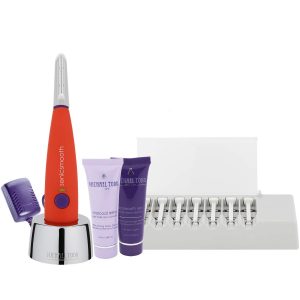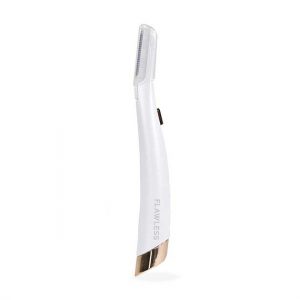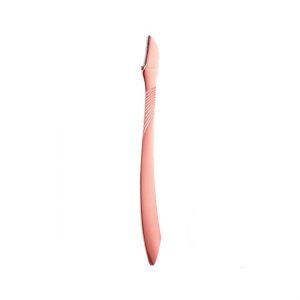In case you didn’t know, you have, well, a lot of dead skin layers on your face that can cause everything from acne and breakouts to dullness and wrinkles. This build-up can even prevent your favorite serums and skin care products from properly penetrating and doing their jobs. While it’s totally normal to have dead skin, there are a variety of ways to slough off these layers to reveal a more radiant complexion—one of the most popular being dermaplaning.
While the name itself sounds kind of crazy, dermaplaning is a non-invasive treatment to remove the dead skin and peach fuzz from your face. The good news is that it requires no downtime—you can even schedule an appointment on your lunch break, and head back to work with your healthiest glow ever.
Sound like a dream come true? Like with any skincare treatment, you most likely want to consider the advantages and disadvantages before pulling the trigger on a professional appointment or on a dermaplaning at-home tool. Here, experts weigh in on the benefits of dermaplaning, as well as side effects, costs, and products that are safe to use at home.
Dermaplaning is a safe, non-invasive facial treatment to remove dead skin and vellus hair—otherwise known as peach fuzz, explains Stacy Cox, Finishing Touch Flawless Skincare expert and esthetician. A sharp blade is used to gently shave and remove the thin, small hairs from your face, leaving your skin smooth and baby-soft, says Rachel Nazarian, MD, a New York-based dermatologist and fellow of the American Academy of Dermatology. And since dermaplaning is a form of physical exfoliation, the result is not only younger-looking skin, but also better product penetration of all your hardworking serums, creams, and anti-aging products, adds Dr. Nazarian.
The benefits of dermaplaning
After a dermaplaning procedure, you’ll notice an immediate brightening effect or glow-up to your overall complexion, points out Cox. Even better? “Skincare products such as serums and moisturizers will absorb more thoroughly and effectively because with both dead skin and peach fuzz absent, products have nothing blocking, hindering or impeding them,” she adds. Plus, makeup will lay more evenly on your skin, since peach fuzz is no longer there to grab onto your foundation or powders.
Side effects of dermaplaning
While the treatment isn’t dangerous and doesn’t hurt, it does leave skin more sensitive and prone to burning, so experts recommend avoiding direct sun. “You should apply a moisturizer with sunscreen to both hydrate the skin, minimize the risk of potential irritation, and protect the skin from sunburn,” advises Joshua Zeichner.
If you have acne or an active breakout, dermaplaning could spread unwanted bacteria around your face. And if you have naturally sensitive skin, like rosacea, you may not want to try this facial treatment, since there may be a chance it could irritate your complexion and increase redness, says Cox.
Also, Cox warns not to schedule a treatment if you have a sunburn or if you’ve just had another procedure done, like a chemical peel, microneedling facial, or an injectable or filler.
But let’s cut to the chase, as we know what you’re really wondering about. If you’re nervous that facial hair will grow back darker or coarser after dermaplaning, fear not. The hair might feel different because it was cut straight across, but it’s actually the same texture as it was before and it will grow at the same speed, shares Cox.
Dermaplaning vs microdermabrasion
Microdermabrasion is a procedure that uses a course hand-piece to physically exfoliate dead cells from the surface of the skin, explains Dr. Zeichner. “It does not remove hair, however it has a similar benefit to dermaplaning in terms of exfoliation,” he adds.
If you have more visible facial hair (and if your goal is to have noticeably less), you might want to opt for dermaplaning over microdermabrasion. While microdermabrasion is a method of removing surface skin cells, it does not address hair growth, so those who have more facial hair might feel “smoother” after dermaplaning, says Dr. Nazarian.
How much does a treatment cost?
Dermaplaning costs can vary, depending on whether you book an appointment at a dermatologist’s office, med spa, or skincare studio. “Professional in-medical office or in-salon dermaplane treatments can range anywhere from as low as $60 to upwards of $200,” says Cox. However, it all depends on the city you live in and if the treatment is stand alone or if other facial services are added to it, like face masks, extractions, or light therapy treatments, she adds.
As for how often you should seek treatment, it’s safe to have dermaplaning performed every two to four weeks, although once a month seems to be the skincare trend with Cox’s clients. But if you have slower hair growth, you can space out your visits.
Dermaplaning at home
While professional treatments can be pricey and inconvenient if you have a hectic schedule, luckily there are affordable dermaplaning tools on the market designed to be used from the comfort of home. “The home use devices have been refined and perfected so you achieve the desired result, but also feel safe and protected in the process,” says Cox.
These at-home gadgets typically have safety features that prevent you from cutting your skin, and several even offer gentle sonic vibrations, which are thought to help stimulate collagen and strengthen the skin, points out Dr. Zeichner.
Want to see what all the fuss is about? Snap up one of our expert-recommended, at-home dermaplaning products below.
Michael Todd Beauty Sonicsmooth Sonic Dermaplaning Device

Dr. Zeichner is a fan of this device, since it combines hair removal with sonic vibrations to help strengthen the skin while offering a brightening benefit. Not only will it leave skin free of peach fuzz, but it also helps to smooth skin texture, target enlarged pores, and minimize fine lines and dullness for a younger-looking, more radiant complexion.
To buy: Michael Todd Beauty Sonicsmooth Sonic Dermaplaning Device (from $75; amazon.com)
Finishing Touch Flawless Dermaplane Glo

This is Cox’s all-time favorite, trusted device, and the one she recommends to her clients for home care treatment. “It has an L.E.D. Light to provide you lots of added support to see exactly where to target on your face, and there’s also a protective safety guard built into this device to spare you from any potential skin nicks,” she raves. Plus, the Dermaplane Glo comes with a protective cover so you can take it on-the-go.
Dr. Nazarian’s pick, this gentle at-home exfoliation tool removes dead skin build-up and peach fuzz—and has disposable blades and easy-grip handles, making it a cinch to use. Developed by an expert aesthetician, it’s safe enough to use weekly and helps soften and smooth fine lines, dark spots, and visible, enlarged pores for glowing skin.
To buy: StackedSkincare Dermaplaning Tool ($75; )
Sephora Collection Shave & Smooth Facial Razor

Dr. Zeichner likes this handheld tool, because you can control it with confidence, thanks to the safety guard, which helps to minimize the risk of cuts to the skin. Made from Japanese steel, the small blade gently and precisely removes facial hair, and the razor comes with three replacement blades to swap in when one starts to become dull.
To buy: Sephora Collection Shave & Smooth Facial Razor ($16; )






